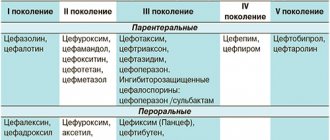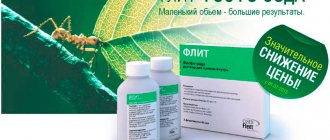Eziklen conc for preparation of solution for oral administration 176ml N2 (Ipsen)
Inside. Adults. To properly cleanse the intestines, two bottles of Esiclene® are required. Before use, the contents of each bottle must be diluted with water. The patient should drink the resulting diluted solution and two more cups filled to the mark with water or an approved clear liquid (i.e., approximately 1 L) over the next two hours. Clear liquids allowed include: water, tea or coffee (without milk or non-dairy creamer), carbonated (carbonated) or still light drinks, clear fruit juices (without pulp, not red or purple), broths or soups strained from solid ingredients . In total, to cleanse the intestines before the procedure, you need to drink at least 3 liters of liquid. The solution after dilution should be used immediately. Application mode. The drug is taken either in a divided use mode (the first bottle is taken the evening before the procedure, and the second - the next morning), or in a one-time use mode (taken on the eve of the procedure). The appropriate regimen for taking Esiclene® can be determined by your doctor. If the time of the prescribed procedure allows, then the split-dose regimen is preferable to the one-time regimen on the eve of the procedure. A single dose regimen on the eve of the procedure is potentially suitable as an alternative regimen. Fractional application mode. The day before the procedure. The evening before the procedure (for example, at 18.00) you must follow the following instructions. The contents of one bottle of Eziklen® should be poured into the supplied measuring cup and diluted with water to the mark (i.e. to a volume of 0.5 l). Over the next two hours, the patient should drink the resulting solution and an additional two measuring glasses of water or clear liquid (i.e., about 1 liter). Day of the procedure. On the morning of the procedure (10-12 hours after taking the drug in the evening), you must repeat the steps according to the instructions for the evening before. The contents of the second bottle of Eziklen® should be poured into the supplied measuring cup and diluted with water to the mark (i.e. to a volume of 0.5 l). Over the next two hours, the patient should drink the resulting solution and an additional two measuring glasses of water or clear liquid (i.e., about 1 liter). Taking the full volume of the diluted solution of Eziklen® and an additional amount of water or clear liquid should be completed at least 2 hours and no later than 4 hours before the start of the procedure. Single use regimen (application regimen for use depending on the individual needs of the patient) Day before the procedure. The evening before the procedure (for example, at 18:00). The contents of one bottle of Eziklen® should be poured into the supplied measuring cup and diluted with water to the mark (i.e. to a volume of 0.5 l). Over the next two hours, the patient should drink the resulting solution and an additional two measuring glasses of water or clear liquid (i.e., about 1 liter). Approximately 2 hours after starting the first dose. The contents of the second bottle of Eziklen® should be poured into the supplied measuring cup and diluted with water to the mark (i.e. to a volume of 0.5 l). Over the next two hours, the patient should drink the resulting solution and an additional two measuring glasses of water or clear liquid (i.e., about 1 liter). Taking the full volume of the diluted solution of Eziklen® and an additional amount of water or clear liquid should be completed at least 2 hours and no later than 4 hours before the start of the procedure. Scheme of dilution and administration of the drug. Open the bottle by pressing on the cap and turning it counterclockwise. Pour the contents of one bottle into the included measuring cup. Dilute the drug with water to the mark (i.e. to a volume of 0.5 l). Slowly drink all the liquid from the glass over 30 to 60 minutes. IMPORTANT. Drink two (2) more scoops of water or clear liquid. Fill the glass to the mark each time. Slowly drink the liquid from each glass over 30 minutes (2 x 30 minutes). Steps 1 to 6 take approximately 2 hours to complete. All steps should be repeated with the second bottle of Esiclene®. After the procedure. To replace fluids lost in preparation for the procedure, patients should drink enough fluids to maintain an appropriate level of hydration. Diet restrictions. A light breakfast is allowed on the day before the procedure. The patient can then consume only clear liquids as food until the procedure. Red and purple colored liquids, milk and alcoholic beverages should be avoided. Special groups of patients. Elderly patients. During clinical studies of the drug, no difference was found in the effectiveness and safety of Eziklen® in elderly patients and patients of other age groups. No dosage adjustment is required for elderly patients, but caution should be exercised when using the drug in these patients, as with any other high-risk population. Patients with impaired renal function. There are limited data on this group of patients. No dosage adjustment is required for patients with mild or moderate renal impairment, but caution should be exercised when using the drug in these patients, as with any other high-risk population. Eziklen® is contraindicated in patients with severe renal impairment. Patients with impaired liver function. There are limited data on this group of patients. No dosage adjustment is required for patients with hepatic impairment; however, caution should be exercised when using the drug in these patients, as with any other high-risk population. Children's population. The safety and effectiveness of Esiclene® in children (i.e., patients under 18 years of age) have not yet been established. No data available.
Compound
magnesium sulfate heptahydrate 3.276 g
sodium sulfate (anhydrous) 17.510 g
potassium sulfate 3.13 g
Excipients: sodium benzoate 0.098 g, anhydrous citric acid 0.315 g, malic acid 0.315 g, sucralose 0.3025 g, purified water 169.641 g, fruit and berry cocktail flavoring 0.7875 g.
The fruit and berry cocktail flavor consists of a mixture of natural and synthetic flavors, propylene glycol (E1520), ethyl alcohol, acetic acid and benzoic acid (E210).
Contraindications
Absolute:
- intestinal obstruction;
- disturbances in gastric emptying (for example, due to decreased activity of the muscular apparatus of the stomach);
- intestinal perforation;
- gastrointestinal obstruction or suspicion of its development;
- toxic colitis;
- profuse vomiting;
- inflammatory bowel diseases in the active phase (for example, ulcerative colitis or Crohn's disease);
- toxic megacolon;
- severe dehydration;
- ascites;
- severe renal failure [glomerular filtration rate (GFR) < 30 ml/min/1.73 m2];
- congestive heart failure;
- age under 18 years;
- period of pregnancy and breastfeeding;
- hypersensitivity to any component of the drug.
Relative (Esiclene should be used with caution if the benefits outweigh the potential risks):
- liver dysfunction;
- mild to moderate renal impairment;
- impaired gag reflex, tendency to aspiration and regurgitation;
- decreased gastrointestinal motility currently (including due to surgery) or in history;
- clinically significant cardiac pathologies;
- conditions characterized by a high risk of developing water and electrolyte imbalance (for example, hypokalemia or hyponatremia);
- simultaneous use of medications that affect the concentration of electrolytes (lithium preparations, diuretics, calcium channel blockers, etc.);
- general weakness or exhaustion of the body;
- elderly age;
- concomitant use of drugs that prolong the QT interval.
special instructions
Esiclene is not intended to treat constipation.
The concentrate must always be diluted with water, otherwise there is a high risk of nausea, vomiting, electrolyte disturbances and dehydration. For the same reason, it is recommended not to forget to drink enough clear liquid.
The sodium content in 1 vial is 247.1 mmol (5.684 g), which should be taken into account by patients on a diet with limited sodium intake.
The potassium content in 1 bottle is 35.9 mmol (1.405 g), which is important to take into account for people on a diet that requires monitoring sodium intake, as well as for patients with reduced kidney function.
Due to the high likelihood of developing a serious electrolyte imbalance, Eziclene should be prescribed to patients at risk only after a careful assessment of the balance between the benefits of use and the possible occurrence of negative side effects. In addition, before starting therapy, it is necessary to exclude the presence of absolute contraindications. Particular attention should be paid to safety precautions.
All patients prescribed Esiclene should be warned of the importance of maintaining an adequate level of hydration before, during and after treatment. If excessive vomiting or signs of dehydration occur as a result of taking the drug, in order to avoid serious complications caused by water-electrolyte imbalance (cardiac arrhythmias, convulsions), rehydration measures should be taken as soon as possible. In addition, laboratory tests to determine electrolyte levels, creatinine concentrations, and blood urea nitrogen concentrations are recommended.
Drinking plenty of water (water or clear liquid) is recommended to maintain adequate hydration levels.
Before prescribing Eziklen and upon completion of its administration, it is necessary to conduct biochemical tests to determine the concentration of electrolytes in the blood serum, and evaluate renal function in weakened and depleted individuals, elderly people, patients with cardiac pathologies, renal and/or liver failure, as well as in patients from groups at risk of developing water-electrolyte imbalance.
Persons with existing disorders of water-electrolyte metabolism or dehydration are given appropriate corrective therapy before prescribing Esiclene.
Electrolyte abnormalities theoretically increase the likelihood of QT prolongation.
Esiclene should be used with caution in the presence of pathological conditions and in patients receiving therapy with drugs that increase the risk of developing potential complications or contribute to the formation of water and electrolyte imbalance. During therapy, these individuals require careful medical supervision.
While taking Esiclene, a temporary increase in the concentration of uric acid (mild to moderate) is possible. This information should be taken into account when prescribing the drug to patients with hyperuricemia and gout.
Impact on the ability to drive vehicles and complex mechanisms
Eziklen does not have a negative effect on the speed of reactions, visual acuity and ability to concentrate.
Use during pregnancy and lactation
The effects of sulfates on reproductive function have not been studied in animal studies. There are no data on the use of Esiclene in women during pregnancy, therefore its use is contraindicated during pregnancy.
It is not known whether the components of the laxative are excreted in mother's milk, but the risk to the nursing infant cannot be completely excluded. If the prescription of Esiclene is clinically justified, breastfeeding should be temporarily stopped. It can be resumed 48 hours after taking the second dose.
The effect of osmotic laxatives on fertility has not been studied.
pharmachologic effect
Combined osmotic laxative.
The mechanism of action is primarily due to the saturation-limited process of active transport of sulfates. When the absorption saturation threshold is reached, sulfates remain in the intestinal lumen.
The osmotic effect of unabsorbed sulfates and the ingestion of a significant volume of water causes water retention in the intestines, which provides a laxative effect, causing profuse watery diarrhea, and leads to bowel cleansing.
Drug interactions
Esiclene for bowel cleansing should be used with caution by patients taking medications that can change the concentration of electrolytes: lithium preparations, diuretics, slow calcium channel blockers, etc.
Esiclene can only be used with precautions during therapy with drugs that prolong the QT interval.
A laxative is expected to cause diarrhea, which may reduce the absorption of any medications taken between 1 and 3 hours after taking Esiclene until the end of the bowel cleansing process. In addition, it is capable of altering the effects of drugs that are used regularly, have a narrow therapeutic index, or have a short half-life. These include, for example, antibiotics, hypoglycemic and antiepileptic drugs, oral contraceptives, digoxin, sodium levothyroxine.


